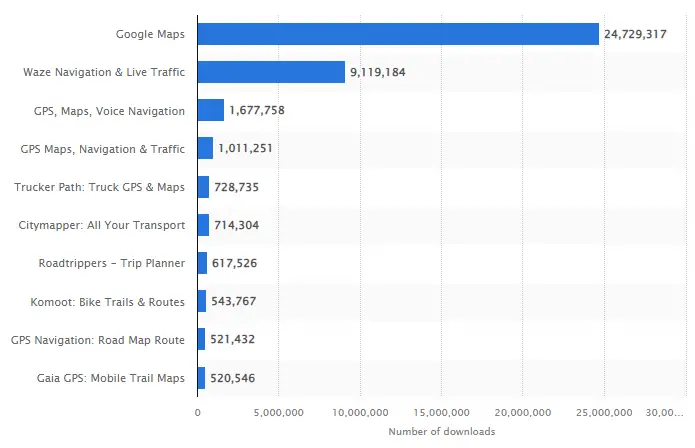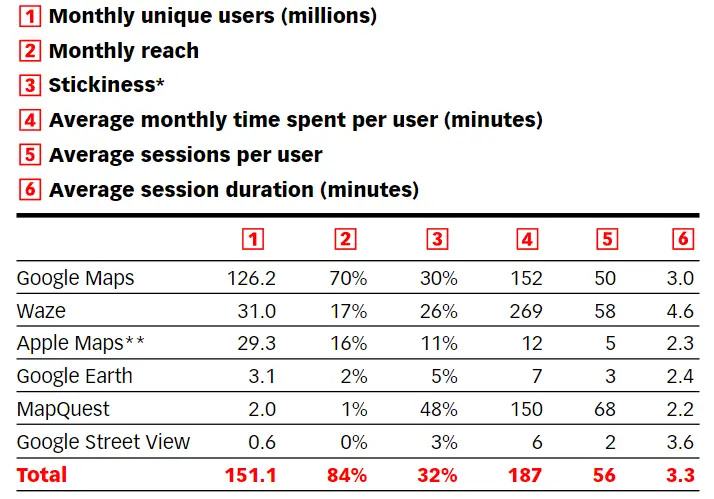Here are the fascinating stats about Google Maps users, statistics, usage, and accuracy.

Google Maps is one of the most widely used mapping and navigation applications in the world. With its advanced features and user-friendly interface, Google Maps has become an essential tool for millions of people who rely on it for directions, real-time traffic updates, and location-based searches.
Google Maps is also the top navigation app on both iOS and Android devices. Users can access the app from their desktops or mobile devices, and can even use it offline.
In addition to providing turn-by-turn directions and real-time traffic information, Google Maps also offers a wide range of features such as Street View, which allows users to see 360-degree panoramic views of streets and landmarks, and satellite imagery, which gives users a bird’s eye view of any location on earth.
Whether you’re exploring a new city, looking for the fastest route to work, or simply trying to find a nearby restaurant, Google Maps has got you covered.
So let’s learn more about Google Maps users, statistics, and usage stats to discover everything this powerful app has to offer!
Most Interesting Google Maps Stats
- Google Maps has over a billion monthly users.
- There are over 120 million Local Guides contributing to Google Maps.
- Google Maps users contribute more than 20 million pieces of information daily.
- 67% of smartphone users prefer Google Maps as their navigation app.
- Google Maps was the most downloaded map and navigation app in the United States.
- Google Maps is used to drive over 1 billion kilometers across the world every day.
- On average, users spend 152 minutes per month on Google Maps.
- On average, Google Maps uses 2.19MB of data per hour and 67KB of data per mile traveled.
- Users typically have 50 monthly sessions on Google Maps with an average duration of 3 minutes per session.
- The journey time estimated by Google Maps is accurate with an average difference of only 1.8 minutes.
- Google Maps ETA predictions are accurate for over 97% of trips taken.
- 73% of websites in the United States are using Google Maps and its API mapping technologies.
- Over 5 million active websites and apps are currently utilizing the Google Maps Platform on a weekly basis.
Google Maps Users Stats
Google Maps has a diverse user base with individuals and businesses from all walks of life and all corners of the world. From tourists and commuters to delivery drivers and real estate agents, the app serves a wide range of needs and purposes.
1. Google Maps has over a billion monthly users. (Google Cloud)
2. More than 120 million Local Guides are contributing to Google Maps. (The Keyword)
3. Google Maps users contribute more than 20 million pieces of information daily. (Google Cloud)
4. The Google Maps app has been downloaded over 10 billion times from the Google Play Store. (Google Play)
5. 67% of smartphone users prefer Google Maps as their navigation app. (TheManifest)
6. Google Maps was the most downloaded map and navigation app in the United States in 2022 with 24.73 million downloads. (Statista)

7. Among all smartphone apps, Google Maps ranked 5th in the US with a 58% penetration rate on smartphones. (Statista)

Google Maps Usage Data & Stats
1. Google Maps is used to drive over 1 billion kilometers across the world every day. (The Keyword)
2. On average, users spend 152 minutes per month on Google Maps. (Insider Intelligence)

3. On average, Google Maps uses 2.19MB of data per hour and 67KB of data per mile traveled. (Statista)
4. Users typically have 50 monthly sessions on Google Maps with an average duration of 3 minutes per session. (Insider Intelligence)
5. The Google Maps webpage received 152 million visits in February 2023. (Similarweb)

6. The United States has the highest number of websites using Google Maps, followed by Japan and the United Kingdom. (SimilarTech)

7. As of December 2022, 73% of websites in the United States are using Google Maps and its API mapping technologies. (Builtwith)
8. Over 5 million active websites and apps are currently utilizing the Google Maps Platform on a weekly basis. (Google Cloud)
9. Google Maps Platform API provides $200 worth of free usage per month, which is equivalent to 28,400 map loads. (Google Maps Platform)
Google Maps Accuracy Stats
1. The journey time estimated by Google Maps is accurate with an average difference of only 1.8 minutes. (Ancoris)
2. Google Maps ETA predictions are accurate for over 97% of trips taken. (The Keyword)
Google Maps Statistics
1. Google Maps is updated continuously, with new information added every second. (Google Cloud)
2. Google Maps has maps available in more than 220 countries and territories worldwide. (The Keyword)
3. Google Maps supports 40 different languages. (The Keyword)
4. Google Maps provides relevant local information for more than 200 million businesses and places worldwide. (The Keyword)
5. Since its launch 12 years ago, Google Maps Street View car and trekker operations have collected over 170 billion images from 87 countries, as of 2019. (The Keyword)
6. Google Earth features high-definition satellite images covering more than 36 million square miles of the Earth’s surface. (The Keyword)
7. Google Earth contains over 40,000 terabytes of geospatial data, which includes historical imagery and scientific datasets collected over 30 years. (Google Earth)
Google Maps Facts & General Stats
1. Google Maps made its debut on February 8, 2005.
2. Google Earth, which came after Google Maps, was launched in 2005. (The Keyword)
3. The Street View feature, which has captured over 10 million miles of street imagery, was launched on May 29, 2007. (The Keyword)
4. The turn-by-turn navigation feature was added to Google Maps in 2009. (The Keyword)
5. Google Maps for mobile was initially launched in November 2007, followed by the Android app in 2008 and the iOS app in 2012. (The Keyword)
6. In June 2014, Google launched Google My Business to help businesses share relevant information on its platform. (The Keyword)
7. Google Maps introduced the offline map feature in November 2015. (The Keyword)
8. As of March 2023, the Google Maps app has a rating of 4.1 out of 5 based on 16.6 million user reviews in the Google Play Store. (Google Play)
9. As of March 2023, the Google Maps app has a rating of 4.7 out of 5 based on 5 million user reviews in the Apple Store. (Apple Store)
Competitors of Google Maps
Google Maps faces competition from various mapping applications, including Waze, Apple Maps, and MapQuest.
Despite the competition, Google Maps remains the leading mapping application by a significant margin.
Interestingly, Google acquired Waze in June 2013, making it a subsidiary of Google.
Other competitors in the mapping space include: WeGo, Sygic, Tom Tom, GPS Maps, Android Auto, Trucker Path, Roadtrippers – Trip Planner, MAPS ME, Gaia GPS – Offroad Hiking Maps, INRIX, Syndicated Maps, and Bad Intersections.
Google Maps vs. Apple Maps: Which is More Accurate and Better?
Google Maps and Apple Maps are two of the most popular mapping applications available for mobile devices. Both apps allow users to search for locations, get directions, and see real-time traffic updates. However, there are some notable differences between the two.
One major difference is the quality of data. Google Maps has a more extensive database of locations and points of interest, while Apple Maps is known to have more accurate data in certain areas.
In general, Google Maps has more extensive mapping data and a larger user base contributing information, which can make it more accurate in areas with high population densities or frequent changes. Google Maps also has more advanced features, which can make it more useful for commuters or those navigating busy urban areas. Additionally, Google Maps has more detailed information on public transit routes and schedules.
On the other hand, Apple Maps has made significant improvements in recent years, and it has been praised for its design and ease of use. Moreover, in some areas, Apple Maps may be more accurate or have more up-to-date information than Google Maps, particularly in areas with newer developments or changes in street layouts.
Another difference is the user interface. Google Maps has a more cluttered interface with many different options and features, while Apple Maps has a simpler and cleaner interface.
However, this can also mean that Apple Maps may be missing some advanced features that users may need.
When it comes to data usage, Google Maps tends to use fewer data than Apple Maps. In a study, it was found that the average amount of mobile data used by Apple Maps per 20 minutes was 1.83 MB, while Google Maps used only 0.73 MB.

Overall, both Google Maps and Apple Maps have their strengths and weaknesses. Users should consider their specific needs and preferences when choosing between the two.
Is Google Maps Good?
Yes, Google Maps is generally considered to be a very good navigation and mapping application that has revolutionized the way people travel and explore new places. It has become an essential tool for millions of users around the world, providing accurate and reliable information on directions, traffic conditions, and nearby businesses.
It is widely used across the world for its accuracy, comprehensive mapping data, and user-friendly interface. It offers various features such as turn-by-turn navigation, real-time traffic updates, transit information, street view, and much more.
One of the key benefits of Google Maps is its ability to provide real-time traffic updates and alternative routes, which can help users avoid congestion and save time. Additionally, the app offers a range of useful features such as voice-guided turn-by-turn navigation, public transit directions, and the ability to save favorite locations and share them with others.
The accuracy of its maps and estimated time of arrival (ETA) predictions is also considered to be very high.
Additionally, Google Maps is regularly updated with new features and improvements, making it a reliable and useful tool for navigation and exploration.
Is Google Maps Accurate?
Yes, in general, Google Maps is considered to be accurate. However, like any technology, it is not perfect and can sometimes have errors or inaccuracies.
Google Maps relies on a variety of data sources to provide accurate information, including satellite imagery, street view data, and user contributions. It also uses real-time data, such as traffic updates, to provide the most up-to-date information possible.
In most cases, Google Maps provides accurate directions and information about points of interest, such as businesses and landmarks. However, there are instances where the app may provide incorrect directions or outdated information. For example, if a road has been closed for construction or if a business has closed permanently, Google Maps may not have updated that information.
Overall, Google Maps is a reliable tool for navigating and exploring new places, but it’s always a good idea to double-check information and use common sense when following directions.
How Often Google Maps Update?
Google Maps is constantly updating its data to provide the most accurate and up-to-date information possible. The frequency of updates can vary depending on the type of data being updated.
For example, Google Maps’ satellite imagery is updated on an ongoing basis, with some areas being updated more frequently than others. Street view data is also updated regularly, with Google sending out specially equipped vehicles to capture new images.
In terms of business and location data, Google relies on a variety of sources to keep its information up-to-date, including user contributions, third-party data providers, and web crawlers that scan the internet for new information. This information is typically updated on a regular basis, with changes being reflected in the app in near-real-time.
Overall, Google Maps is constantly updating its data to provide users with the most accurate and up-to-date information possible. However, it’s important to keep in mind that there may still be errors or inaccuracies, particularly in areas where data is less frequently updated.
Google Maps Traffic Data
Google Maps uses a variety of sources to provide real-time traffic data to its users. This includes data from Google’s vast network of mobile devices, as well as data from third-party sources such as government agencies and private data providers.
Google Maps uses this data to provide accurate and up-to-date information on traffic conditions, including congestion, accidents, and road closures. This information is then used to calculate the fastest route to a destination, taking into account current traffic conditions.
In addition to providing real-time traffic updates, Google Maps also allows users to view historical traffic data, which can be useful for planning a trip or avoiding particularly busy times on the road.
Overall, Google Maps’ traffic data is generally considered to be accurate and reliable, though it’s worth noting that there can be occasional errors or delays in the data, particularly in areas where there are fewer mobile devices reporting data.
How to Check Google Maps Traffic Data History?
Google Maps provides users with the ability to view historical traffic data for a particular area or route. This feature allows users to see how traffic conditions have changed over time and can be useful for planning a trip or avoiding busy times on the road.
To access historical traffic data on Google Maps, users can follow these steps:
- Open Google Maps and enter your destination or route.
- Click on the “Directions” button and enter your starting point.
- Click on the “Options” button, located next to the “Starting point” and “Destination” fields.
- Select “Depart at” and choose a date and time in the past.
- Click “Done” to see the historical traffic data for that route.
Once you have selected a date and time, Google Maps will display a color-coded traffic map that shows how traffic conditions were at that time. Green indicates no traffic or very light traffic, yellow indicates moderate traffic, orange indicates heavy traffic, and red indicates very heavy traffic.
Overall, Google Maps’ historical traffic data can be a useful tool for planning a trip or avoiding busy times on the road. However, it’s worth noting that the data may not be 100% accurate, as it is based on the information that was reported at the time.
Google Maps Revenue: How Google Maps Makes Money?
Google Maps generates revenue for its company through various methods. One of the main ways is through ad placements from businesses on the platform. Whenever a Google Maps user searches for business information, search listing ads appear, and the businesses that are advertised are charged for the ad placements.
Another way Google Maps generates revenue is through Branded Map Icons, which allow businesses to display their company-branded icons on Google Maps instead of a common icon. This revenue model is based on a CPM (cost per thousand impressions) basis, and Google charges the companies every time the branded icon is displayed.
Furthermore, Google Maps generates revenue through its Google Maps Platform, which provides mapping, navigation, and tracking services through the use of Google Maps API. Companies such as ride-sharing, food and item delivery, and courier companies use the platform and pay for its services.
Can Google Maps be Used offline?
Yes, it is possible to use Google Maps offline without the internet by downloading the map area ahead of time.
To learn how to download Google Maps for offline use, follow the steps provided in the article.
- For Android users, instructions can be found here:
- For iPhone users, instructions can be found here:
Conclusion of Google Maps Users & Statistics
Google Maps has revolutionized the way people navigate and explore the world, and it continues to be a trusted and reliable tool for millions of users worldwide.
With its user-friendly interface, accurate information, and constant updates, it is likely to remain the go-to mapping application for years to come.
We hope that these Google Maps statistics help you learn more about this amazing navigation and mapping application.
Sources:
More Interesting Statistics:
